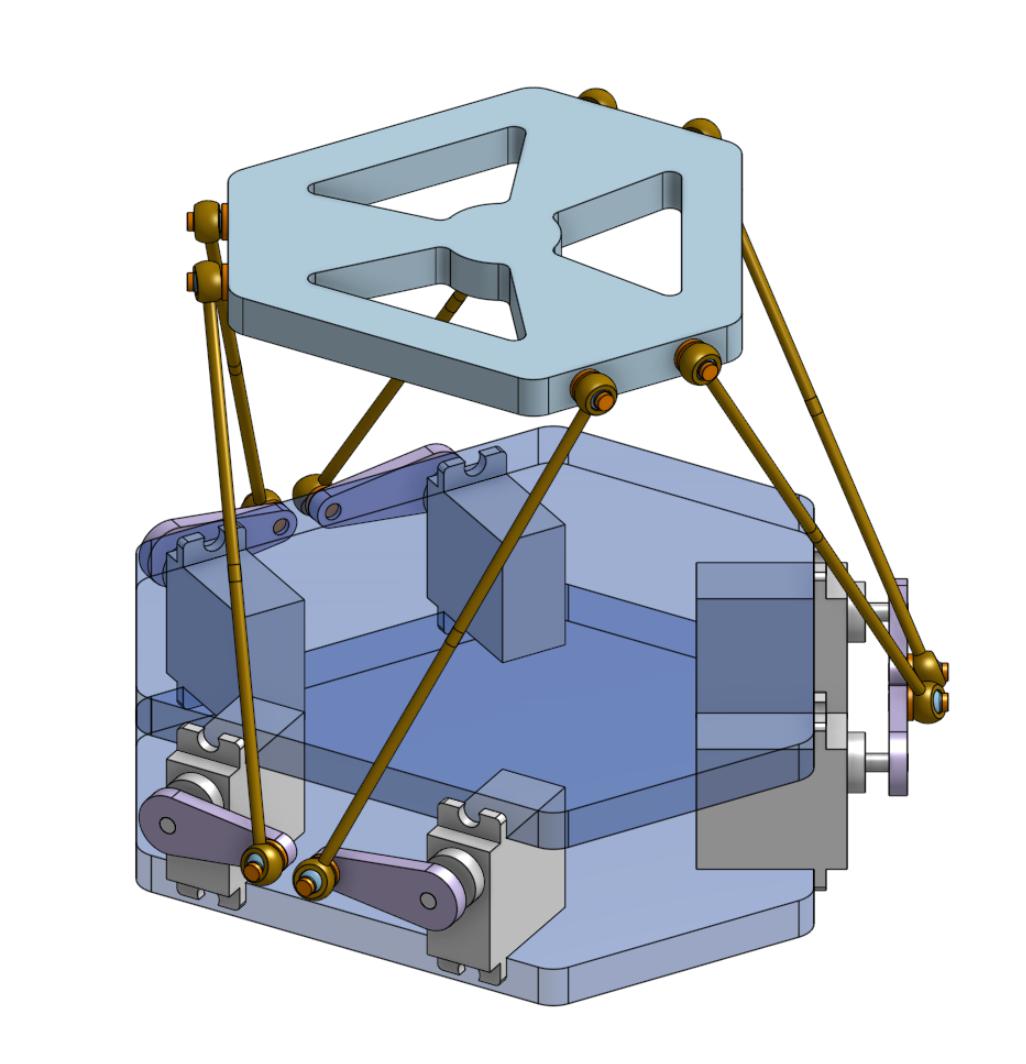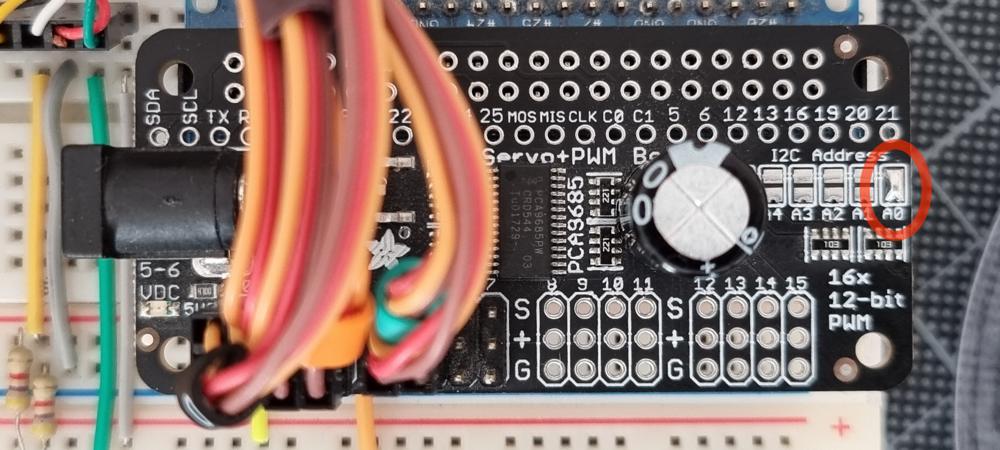
|
This repository is archived in the GitHub Arctic Code Vault. |
This is an ESP32 implementation of a six-degree-of-freedom hexapod — also called Stewart Platform, Gough-Stewart Platform or Parallel manipulator. The actuators are PWM rotary servo motors and the program is written in Arduino C compiled with PlatformIO. This project is done in the frame of the P19 project at the Microclub.
Currently the platform can be operated:
- With a Nunchuck.
- With Arduino C code (see
Hexapod_Demo.cpp). - With G-Code sent by a computer to the ESP through the serial port (see
python/gcode2serial.py).
The calculation of the kinematics is performed in Hexapod_Kinematics.cpp and can be also be compiled in a desktop C++ program to cross-check calculations (i.e. without actuating the servos).
I managed to compile it with g++ on macOS Mojave and macOS Monterey.
See hexapod_desktop_app/hexapod_desktop_app.cpp.
The home page is a work in progress, but the video shows what the platform can do. The original implementation used an analog joystick, but the current version uses a Wii Nunchuck.
The automatic translation in English can be read here:
https://ouilogique-com.translate.goog/plateforme-de-stewart-esp32/?_x_tr_sl=fr&_x_tr_tl=en
The original version in French is here:
https://ouilogique.com/plateforme-de-stewart-esp32/
- Change the default I²C address of the PCA9685 driver from
0x40to0x41by shorting the A0 jumper beside the capacitor.
- Create a file called
src/WifiSettings.hcontaining:
#pragma once
const char *ssid = ""; // SSID of your WiFi router.
const char *password = ""; // Password of your WiFi router.
const char *ap_ssid = "STEW32-"; // SSID of the ESP32 WiFi network in soft-AP mode (15 char max).
const char *ap_password = ""; // Password of the ESP32 WiFi network in soft-AP mode.
// Must be 8 char min or empty for no password.Geometry settings are defined in
Hexapod_Config_1.h.
The meaning of the parameters is explained in
doc/hexapod-parameters.pdf.
The two base plates are identical and the DXF file to reproduce them is here (right-click + save as):
doc/hexapod-base-plate.dxf.
The top plate is 3D-printed (right-click + save as):
doc/hexapod-top-plate.stl.zip.
| QTY | PART |
|---|---|
| 1 | WeMos ESP32 WROOM |
| 1 | Adafruit PCA9685 16-Channel Servo I²C Driver |
| 1 | Breadboard adapter for PCA9685 |
| 1 | 5 V / 10 A power supply |
| 6 | Rods M3x100mm (140mm total) |
| 6 | ¹ Tower Pro MG996R servo (clone) |
| 1 | Nunchuck |
| 1 | ² Nunchuck cable extension |
| 1 | ³ Adafruit Wii Nunchuck Breakout Adapter |
| 1 | 6 pin Dupont connector to connect Nunchuck to breadboard |
| 1 | Set of cable markers |
| 6 | M3×5×6 Brass insert nuts |
| 12 | Small screws to hold the motors on the base plates |
| 6 | M3×12 screw |
| 6 | M3×12 nut |
| 1 | Breadboard |
| some | Breadboard wires |
| 2 | 4.7 kΩ resistor |
- ¹ I currently use clones of the Tower Pro MG996R servos, but they are bad and I don’t recommend them.
https://fr.aliexpress.com/item/32636102294.html
I formerly used clones of the Tower Pro MG90s Servos, but they were also bad and too small for this application. https://www.banggood.com/6X-Towerpro-MG90S-Metal-Gear-RC-Micro-Servo-p-1072260.html
In the future, I will probalbly use Parallax 900-00005 servos. It seems that these are the one used by fullmotiondynamics in their videos. https://www.parallax.com/product/900-00005 - ² The Nunchuck cable extension is not mandatory. The idea is not to have a longer cable but rather to use the extension as an adapter between the Nunchuck and the breadboard, that is to say that it allows to leave the Nunchunk cable uncut.
- ³ This breakout adapter is not mandatory, but it could simplify wiring. I haven’t used it myself.
The Nunchuck library uses
Wire.hand standard I²C connections internaly.Pins are seen from left to right and top to bottom looking at the Nunchuck connector.
Cut the cable extension to connect to the ESP32.
| color | signal | ESP32 pin |
|---|---|---|
| white | SCL | IO22 |
| NC | ||
| red | GND | GND |
| green | VCC | VCC |
| black | ATT | IO32 (or connect to 3.3V to force Nunchunk detection) |
| yellow | SDA | IO21 |
The external libraries are installed automatically during the first build because they are declared under lib_deps in platformio.ini.
By default, the PCA9685 driver and the Nunchuck share the same I²C address
0x40. Fortunately, the address of the PCA9685 driver can easily be changed to0x41by shorting the A0 jumper next to the capacitor.
| Default address | New address | Device |
|---|---|---|
| 0x40 | 0x41 | PCA9685 |
| 0x70 | = | PCA9685 (broadcast) |
| 0x40 | = | Nunchuck (IMU) |
| 0x52 | = | Nunchuck (joystick) |
| 0x68 | = | GY-91 (MPU9250) |
| 0x76 | = | GY-91 (BMP280) |
- San-José State University / Full Motion Dynamics:
- https://www.youtube.com/watch?v=j4OmVLc_oDw
fullmotiondynamics.com
- Hexapod kinematics of this project was originaly based on 6dof-stewduino, by Philippe Desrosiers, althought I reworked it in depth:
- He derived his implementation from the work of Daniel Waters:
- Kinematics calculation is also explained in this document by an unknown author from the Wokingham U3A Math Group:
- The project memememememememe was also an excellent source of inspiration. They share the code for RPi and a simulator in the Processing langage:
- Derived from MarginallyClever:
- PID Control System Analysis and Design, By YUN LI, KIAM HEONG ANG, and GREGORY C.Y. CHONG
- See Table 1, p.33 http://eprints.gla.ac.uk/3815/1/IEEE_CS_PID_01580152.pdf
- Understanding PID Control, Part 1: What is PID Control?
- Modern Robotics, Chapter 7: Kinematics of Closed Chains


